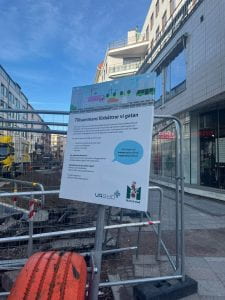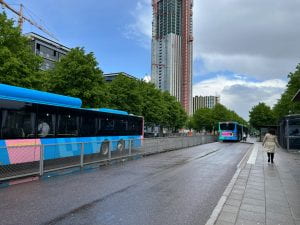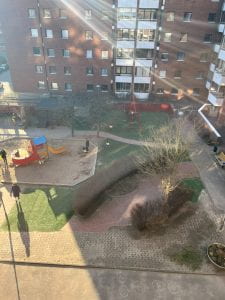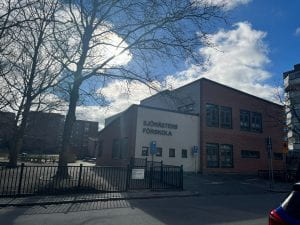In this series of blog posts, I will summarize and describe sabbatical research conducted while living in Malmö Sweden for 4 months in 2022.
Part 1: Research Approach
Part 2: Policy Context
Part 3: “National Negotiation” Overview
Part 4: Key Lessons Learned
Originally, I intended to blog about research more frequently, but I got immersed in the experience and the research process. I will start this series by describing how I approached this study and undertook research. As I’ll discuss later, conducting research in a different language and policy context offered some puzzles to figure out.

Malmö Street Construction to Prepare for Express Buses
I became interested in this policy after hearing about it on our study abroad class in 2019 during a presentation by the city of Malmö bicycle planners who were talking about massive expansion in bus and bike infrastructure thanks to funding from the Swedish government under the “big city package.” Under the “National Negotiation on Housing and Infrastructure,” (Sverigeförhandlingen) the national government builds cycling and transit infrastructure in exchange for the local government committing to a specific number housing units to accommodate population growth within the major cities of Malmö, Stockholm, and Gothenburg. I found this policy to be innovative and collaborative by trading massive infrastructure investment needed to support climate targets for dense housing needed to support bicycling and transit.
I want to understand how this policy was adopted and implemented, and carry lessons learned back to the U.S. context. My objectives:
1) To understand the political context and policy adoption process for the National Negotiation on Housing and Infrastructure, including how land use regulations and transportation finance changed.
2) To learn where the policy has influenced local decision making and urban form and where the policy has diverged from original conception to actual implementation locally; and
3) To apply lessons learned to inform policy formulation and implementation at a local, state, and federal level in the United States.
Approach
To conduct this research, I lived in Malmö, Sweden for 4 months, where I held a visiting researcher appointment at Malmö University within the Department of Urban Studies. I began my research by identifying, downloading, translating, and summarizing key policies related to housing, land use, and transport. To examine this policy, I needed to understand the systems governing the use of land, construction of housing, and provision of transportation infrastructure. I also needed to understand governance and taxation at a local, regional, and national level. Colleagues at Malmö University offered informal knowledge to confirm my understanding of policy prior to conducting interviews.
I gathered and translated national and city level documents that described the “Big City” agreements in Malmö, Stockholm, and Gothenburg. These documents included the original frameworks, annual reports, and quarterly meeting meetings. After summarizing these documents, I began scheduling interviews with key stakeholders at a national, regional, and local level. Within each city, I scheduled interviews with planners, regional transit providers, bicycle infrastructure designers, and national transportation agency staff. I also conducted site visits to see the places where new housing is being planned/constructed. To glean lessons learned for the U.S., I probed interviewees on the policy adoption process, collaboration, implementation, and key lessons learned.
| Component |
Intent |
Approach |
| 1) Context – Housing, Transportation, Land Use |
a) Describe context for land use planning and transportation planning in Sweden
b) Describe real estate and housing approach in Sweden to understand methods of allocation and construction
|
a) identified Swedish names for key documents including comprehensive plan, detailed plan, mobility plan, housing supply plan, etc
b) locate and download documents in Swedish
c) translate documents into English using Google Translate
d) Read and summarize key documents
e) Verify understanding of approach with colleagues |
| 2) National Negotiation – Context |
a) Describe the intent and goals of National Negotiation
b) Summarize key agreements with big cities: number of housing units, transportation investments, timeline, cost
c) Document progress to implement key projects (create maps) |
a) identified Swedish names for key documents including final report, annual reports,
b) locate and download documents in Swedish
c) translate documents into English using Google Translate
d) Read and summarize key documents
e)Search documents and websites to identify areas (using maps) of transit expansion and housing development (target for site visits)
|
| 3) National Negotiation – Evaluation
|
a) Obtain perspectives on policy adoption and strengths and weaknesses of approach
b) Visualize new housing construction to visualize transformation (photos)
c) Visualize new transportation infrastructure (photos) |
a) Search websites to identify names to contact (note – most email addresses for individuals not readily available in Sweden)
b) Set up and conduct interviews with key individuals at the local, regional, and national level representing housing, transportation, and land use
c) Using research from Part 2 conduct site visits
|
| 4) Synthesis |
a) Examine key lessons learned from adoption to inform policy in the United States. In particular, I will focus on Oregon because it is the most innovative land use and transportation policy state in the U.S. and presents a useful context to analyze transferability of this Swedish policy.
b) Offer broader recommendations for local, state, and federal roles, including funding mechanisms. that are applicable nationwide.
|
a) Write up and describe research process
b) Synthesize information from stakeholder interviews to develop key themes
c) Write up final report |

Gothenburg – Construction and street for new tramline
In addition to the academic description above, I want to offer a bit of reflection on some of the differences and challenges with doing research on a policy in a different country. While I’ve participated in comparative research in the past and led educational experiences abroad, conducting qualitative research in another country and another language was new to me.
I came across three different challenges:
- Language and document access: I heard about the policy from a presentation and was able to find a 4 page summary in English. I found the same thing for the comprehensive plan. As I got more settled in Sweden, I figured out what the Swedish words for various documents and thus, how to search for them. The English versions of documents were ~10-20 pages but the Swedish versions are 300+ pages! Then I was able to locate and download documents in Swedish, and then use Google Translate to translate them into English – it’s not perfect, but it gives me the gist of what I need to know even if the wording might sound a bit awkward. I did a lot of independent research and then verified my understanding through informal conversations with university colleagues.
- Finding interview contacts: My colleagues had some connections the helped me get in the door for interviews, but in some cases I had trouble finding the names and email addresses of appropriate contacts. I scoured annual reports and meeting minutes to find names of key staff at the city level but often found higher-level officials (like city managers) rather than technical experts. I could sometimes find names, but no email addresses meaning that I emailed a general email account for the city and awaited a response to get connected to the right people. (Somewhat of a black box approach.) This actually worked out (to my surprise!), but it took more time than I anticipated.
- Technical conversations in another language: As I’ve mentioned, English is spoken fluently and extensively throughout Sweden as it’s part of primary education across the country. As an English speaker, it was easy to take this for granted – I was extremely lucky that I was able to conduct interviews in my native (and only fluent) language and that contacts were willing to speak to me. Several times, my interviewees noted how they hadn’t spoke English recently (partially due to COVID and the lack of visitors/travel) and how difficult it was to find the translation for technical terms. I joked with one interview about how talking in English at a coffeeshop is much different than talking about comprehensive planning. This part of the process gave me a new perspective on something I had been taking for granted and gave me a great appreciation for the time and attention people gave me. As I plan to continue collaborating in Sweden, it has also encouraged me to continue my study of the language so I can get more up to speed in these conversations.
In the next series of blogs, I’ll describe and summarize my understanding of context and policy.







































